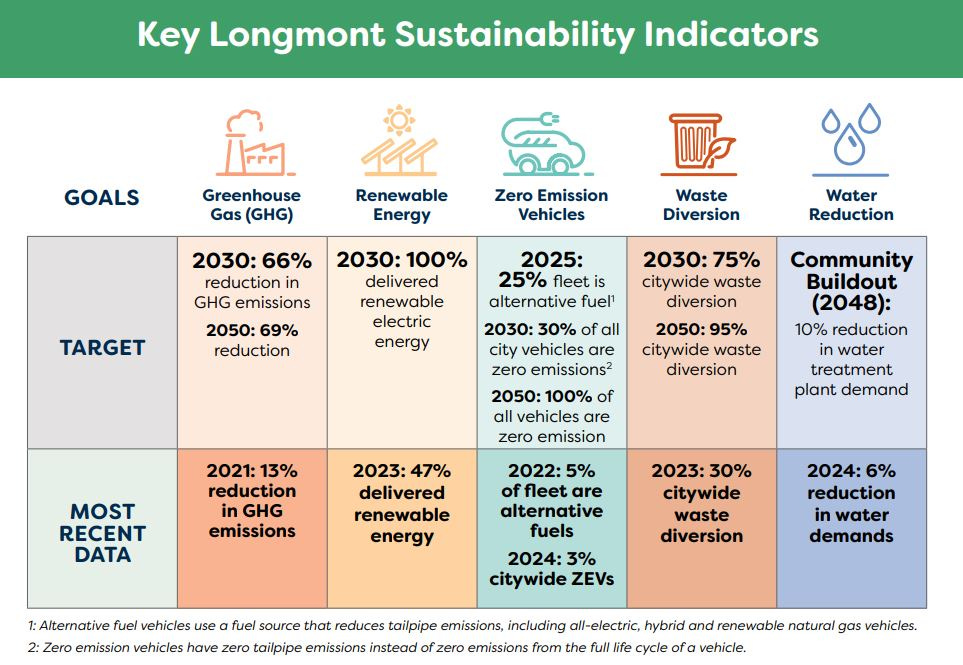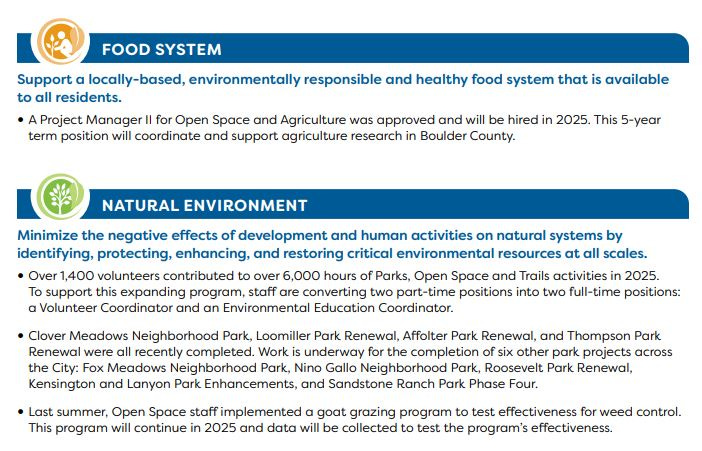Feedback on 2025 Longmont Sustainability and Climate Action Report: Lack of Regenerative Focus Cripples the City’s Climate Commitment
A PR Document Rather Than a Serious Sustainability Report?
Featuring flashy graphics and boilerplate platitudes, at its core, the 2024-2025 Longmont Sustainability and Climate Action Report reads more like a public relations document than a rigorous sustainability assessment. While the city presents a polished narrative of progress, the report lacks the depth, transparency, and urgency necessary for serious climate action. Instead of providing a frank evaluation of failures and setbacks, the report highlights small-scale successes and symbolic initiatives while ignoring the structural barriers that are preventing Longmont from meeting its most critical sustainability goals. If Longmont is truly committed to sustainability, it must shift from a self-congratulatory reporting style to an evidence-based, solutions-driven approach that holds itself accountable for real progress.
One of the most glaring weaknesses of the report is its decision to further reduce reporting frequency. Over the past several years, Longmont has regressively moved from quarterly updates to biannual reports, and now to an annual report format—a clear step backward in transparency. Less frequent reporting means less oversight, fewer opportunities for public engagement, and a greater ability to obscure lack of progress. Given that Longmont is significantly behind on key goals, including greenhouse gas reductions, “Zero Emission Vehicle” adoption, renewable energy, and waste diversion, more frequent and detailed reporting is needed—not less. A robust sustainability framework requires consistent and rigorous evaluation of progress, failures, and needed adjustments, not a once-a-year summary designed to highlight positive developments while minimizing deficiencies.
The lack of clear explanations for goal failures is another significant flaw. While the report presents data on current progress toward 2030 and 2050 targets, it fails to analyze why certain targets are not being met and what corrective actions are being taken. For example, the city’s waste diversion rate remains stagnant at 30%, far from the 75% goal for 2030, yet the report does not explore what policies, infrastructure, or voluntary incentives could drive higher participation in waste reduction efforts. Similarly, greenhouse gas emissions reductions are far below target levels, yet the report provides no discussion of which policies are underperforming or what additional measures will be implemented to accelerate decarbonization. A true sustainability report should acknowledge shortcomings and outline concrete action plans for improvement, rather than simply listing progress without context.
A particularly egregious failure of the report is its inability to address the core contradiction in Longmont’s decarbonization strategy—its reliance on PRPA’s plan to build a new gas-fired power plant. The report claims that Longmont is on target to achieve 100% renewable electricity by 2030, yet it fails to account for the long-term impact of investing in new fossil fuel infrastructure. Instead of blindly accepting PRPA’s deeply flawed approach, Longmont civic leaders should be leading the charge for an alternative pathway that maximizes renewable integration while avoiding unnecessary fossil fuel investments.
One of the most critical oversights in the report is the lack of a serious strategy for scaling up distributed solar energy. Rooftop solar—on homes, businesses, municipal buildings, and industrial sites—has the potential to significantly reduce Longmont’s reliance on centralized power generation and enhance energy resilience. Yet the report barely mentions local solar adoption and does not outline any policy measures to accelerate the deployment of small-scale renewable energy systems. Instead, the city remains dependent on top-down utility planning that prioritizes large-scale infrastructure projects, such as the wasteful and harmful boondoggle of advanced metering, over decentralized, community-driven energy solutions.
A serious sustainability strategy would focus on empowering residents, businesses, and institutions to generate their own clean energy, store excess power, and contribute to a flexible and resilient grid. This requires removing barriers to rooftop solar installations, streamlining permitting processes, and providing voluntary incentives for home and business owners to invest in renewable energy systems. The lack of attention to distributed solar in the report is a major failure—one that reinforces the city's over-reliance on PRPA rather than charting a truly independent, resilient energy strategy.
Beyond energy policy, the report lacks a compelling vision for how Longmont will create a truly sustainable and self-sufficient local food system. The entire section on food sustainability contains only a single update: the hiring of a Project Manager II for Open Space and Agriculture in 2025 to coordinate research in Boulder County. This is an unacceptable omission, as a robust local food system is essential to sustainability, resilience, and climate adaptation. While I greatly appreciate the many hours of work committed by volunteers and staff to maintain and improve the city’s beautiful parks, the failure to include tangible progress on urban agriculture, regenerative farming incentives, and food security programs reflects a narrow view of food systems and the natural environment that does not address the systemic nature of the challenges Longmont faces.
A Missed Opportunity for Regenerative Solutions
The fact that the report fails to mention tree planting efforts or meaningful regenerative agriculture initiatives is a serious problem that points to a broader issue: Longmont’s sustainability strategy does not adequately emphasize regenerative solutions. While the city claims to prioritize environmental stewardship and resilience, the absence of tree planting initiatives, ecosystem restoration projects, soil carbon sequestration, and tangible regenerative agriculture programs suggests a fundamentally incomplete approach to climate action.
1) Lack of Emphasis on Tree Planting and Urban Forestry
Missing Data on Tree Planting
One of the simplest and most effective carbon sequestration strategies is large-scale urban tree planting.
Trees provide:
Carbon sequestration and improved air quality
Urban cooling to combat extreme heat
Soil stabilization and erosion prevention
Increased biodiversity and habitat creation
Yet, this report contains no mention of how many trees were planted in 2024 or any commitment to expanding Longmont’s urban tree canopy.
Why This Matters:
Cities across the U.S. are implementing aggressive urban forestry programs to increase canopy cover.
Longmont has faced increasing heatwaves and air pollution. More trees = more cooling and air filtration.
PR efforts vs. real action? The city promotes resilience, yet tree planting—one of the simplest, most cost-effective, and highest-impact solutions—does not merit a single mention in this report.
Without a documented urban forestry plan, Longmont is failing to integrate a critical nature-based climate solution.
2) Weak Approach to Regenerative Agriculture
The Food System Section is Inadequate
The Food System section in the report is shockingly weak and includes only one update:
“A Project Manager II for Open Space and Agriculture was approved and will be hired in 2025. This 5-year term position will coordinate and support agriculture research in Boulder County.”
This raises several serious concerns:
- No mention of actual regenerative agriculture programs or investments.
- No updates on soil restoration, carbon sequestration in agriculture, or sustainable land use initiatives.
- No evidence that Longmont is moving toward a resilient, local food system.
Hiring one project manager to "support agriculture research" is not an action-based climate solution. A real commitment to regenerative agriculture would include:
Support for local farmers transitioning to regenerative practices.
Expanding clean, non-toxic composting and soil regeneration projects.
Partnerships with Boulder County to implement large-scale carbon farming initiatives.
Investment in urban farming and gardening, edible landscapes, and community food forests.
No Discussion of Local Food Production or Urban Farming
A sustainability plan that prioritizes local food security should address:
How much food is grown locally vs. imported?
How the city is supporting regenerative farmers?
What percentage of city land is dedicated to local food production?
What food justice initiatives exist to ensure marginalized communities have access to fresh food?
Longmont’s sustainability plan completely ignores these key food system elements, which indicates that food security and soil health are not truly priorities.
3) No Investment in Regenerative Landscape Restoration
The report mentions multiple park projects, but there is no discussion of regenerative landscaping, prairie restoration, or pollinator habitat expansion.
Missed Opportunities for Ecosystem Regeneration
- Where are the native plant restoration projects?
- Where are the prairie grassland restoration efforts?
- What steps is the city taking to restore degraded land and prevent soil erosion?
If the city is serious about climate resilience, it should prioritize ecological restoration—yet this report suggests these efforts are either non-existent or too small to be reported.
4) The Absence of Natural Carbon Sequestration Strategies
While the report heavily focuses on emissions reductions, it completely ignores nature-based carbon sequestration.
The sustainability plan should integrate:
- Soil carbon sequestration through regenerative farming
- Reforestation and agroforestry projects
- Expanding wetlands and riparian buffers
Without these solutions, Longmont will struggle to meet its net-zero goals. The IPCC has repeatedly emphasized that reducing emissions alone is not enough—carbon drawdown is essential. This report fails to acknowledge this reality.
If Longmont is ignoring nature-based carbon sequestration, its climate plan is incomplete and fundamentally flawed.
5) Lack of Discussion on Climate Adaptation Through Regenerative Solutions
While the report briefly touches on resilience, it does not connect the dots between regenerative solutions and climate adaptation.
Why This Matters:
Regenerative agriculture improves drought resilience. Why isn’t this a focus for Longmont?
Tree planting and soil restoration reduce flooding risks. Why is this missing from the resilience discussion?
Biodiverse landscapes improve food security and ecological health. Yet the city either isn’t investing in these solutions or isn’t talking about them.
Instead, the city continues to frame sustainability through a narrow, technocratic lens (EVs, solar panels, waste diversion) without acknowledging the foundational role of ecological regeneration in true sustainability.
If Longmont’s climate plan does not integrate ecosystem restoration and regenerative solutions, it will fail to build true resilience against climate change.
6) The Report Reflects a Business-as-Usual Mindset, Not a Transformative Vision
The entire tone of the report is incremental, bureaucratic, and conventional.
No bold commitments to transform food systems, landscapes, or ecological restoration.
No real financial investments in regenerative projects.
No meaningful partnerships with regenerative farmers, Indigenous land stewards, or conservationists.
Sustainability isn’t just about making current systems “less bad.” It’s about regenerating ecosystems, restoring balance, and creating thriving, biodiverse landscapes.
This report does not reflect that deeper, holistic approach to sustainability.
A sustainability plan that fails to integrate regenerative solutions is not a true climate action strategy—it’s a weak, incomplete roadmap that will leave Longmont vulnerable to climate disruptions.
Final Conclusion: The Report Fails to Prioritize and Integrate Regenerative Solutions
Key Weaknesses Identified
No urban forestry or large-scale tree planting efforts
Food system section is an afterthought with no real regenerative agriculture initiatives
No mention of soil restoration, native plant restoration, or carbon sequestration strategies
No real commitment to climate adaptation through ecosystem-based solutions
Fails to recognize the role of nature in long-term climate resilience
Without prioritizing regenerative solutions, Longmont’s climate action plan will continue to fall short.








These "climate action plans" are comical in their unseriousness and virtue signalling but remain a threat to any city or other governmental entity that adopts them.
LA and San Diego's are ridiculous as well:
https://www.greenleapforward.wtf/p/americas-finest-magical-thinking?utm_source=publication-search
https://www.greenleapforward.wtf/p/americas-finest-magical-thinking?utm_source=publication-search